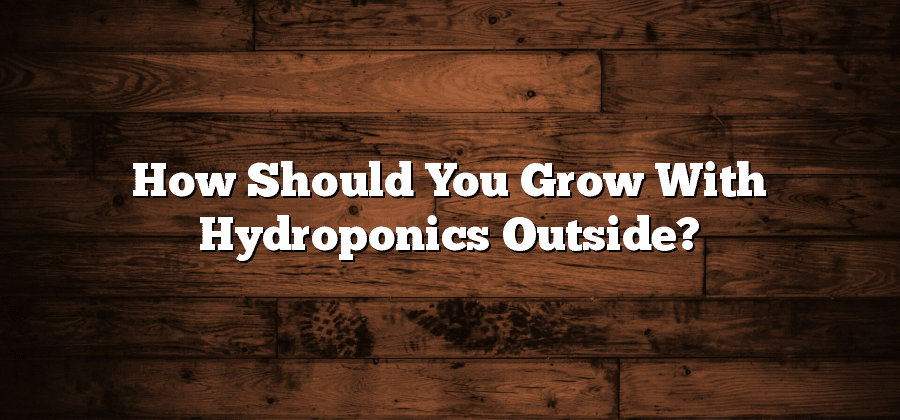Setting Up a Hydroponic System in Your Outdoor Space
Hydroponics is an innovative and efficient method of gardening that allows you to grow plants without the need for traditional soil. Setting up a hydroponic system in your outdoor space can not only maximize your gardening potential, but also offer a rewarding and sustainable way to grow your own produce. Whether you have limited space or simply want to explore a new gardening technique, hydroponics can be the perfect solution.
The first step in setting up a hydroponic system in your outdoor space is to select the right setup. With a wide range of options available, it’s important to choose one that suits your needs and preferences. From drip systems to nutrient film techniques, each setup has its own advantages and considerations. Researching and understanding the different setups will enable you to make an informed decision and set the foundation for a successful hydroponic garden.
Selecting the Right Hydroponic Setup for Outdoor Growing
Hydroponic systems come in various designs and configurations, making it crucial to select the right setup for outdoor growing. One popular choice is the nutrient film technique (NFT) system, which is ideal for gardeners with limited space. NFT systems rely on a shallow channel to deliver a nutrient-rich solution directly to the plant roots, providing them with the necessary elements for growth. This setup is particularly effective for leafy greens and herbs, making it an excellent option for those interested in growing fresh produce for consumption.
Another option to consider is the deep water culture (DWC) system, which involves suspending plant roots in a nutrient solution. This setup is relatively simple and inexpensive, making it a popular choice for beginners. The plants are kept in a container filled with the nutrient solution, allowing their roots to absorb the necessary nutrients directly. The oxygenation of the solution is crucial in DWC systems to prevent root rot. With proper management, DWC systems can yield impressive results, making them suitable for a wide range of plants, including tomatoes, cucumbers, and peppers.
When selecting the right hydroponic setup for your outdoor growing endeavors, it is essential to consider factors such as available space, the types of plants you want to grow, and your level of experience. By understanding the different options available and their specific requirements, you can choose a setup that best suits your needs and ensures successful cultivation in your outdoor hydroponic garden.
Choosing the Ideal Location for Your Hydroponic Garden
Choosing the ideal location for your hydroponic garden is essential for the success of your outdoor hydroponic system. There are several factors to consider when determining the best spot for your garden. First and foremost, the location should receive ample sunlight throughout the day. This is crucial as sunlight is the primary source of energy for your plants to photosynthesize and grow. Look for a spot that gets at least six to eight hours of direct sunlight, preferably during the morning and early afternoon.
In addition to sunlight, you should also consider the accessibility of the location. Ensure that the area is easily accessible for maintenance tasks such as watering, fertilizing, and harvesting. Having a nearby water source will also make it more convenient to supply your hydroponic system with water. Furthermore, consider the proximity to your living space, as having your garden within easy reach will make it more enjoyable to tend to and monitor its progress.
By carefully choosing the ideal location for your hydroponic garden, you will provide your plants with the optimal conditions for growth and maximize your chances of a successful outdoor hydroponic system.
Understanding the Essential Components of an Outdoor Hydroponic System
Hydroponic gardening has gained popularity over the years for its ability to produce high-quality crops in a controlled environment. When setting up an outdoor hydroponic system, understanding the essential components is crucial for success. These components not only provide the necessary support and nutrition for your plants but also ensure optimal growth and productivity.
One of the key components of an outdoor hydroponic system is the growing medium. Unlike traditional soil-based gardening, hydroponics uses inert materials such as perlite, vermiculite, or coconut coir as a substrate for the plants’ roots. This allows for better aeration and nutrient absorption, promoting healthier root development and ultimately improving overall plant health. Additionally, a reservoir or tank is necessary to hold the nutrient solution, which is a carefully balanced mixture of water and essential plant nutrients. This ensures the plants receive the necessary elements for growth, without the need for soil.
Preparing the Soil for Outdoor Hydroponics
When it comes to preparing the soil for outdoor hydroponics, traditional gardening practices must be set aside. In hydroponics, soil is no longer the primary medium for growing plants. Instead, a nutrient-rich solution is used to support plant growth. However, it is still important to ensure that the outdoor space where you plan to set up your hydroponic system is properly prepared.
Firstly, remove any existing vegetation or weeds from the area. This is crucial to prevent competition for resources between the hydroponic plants and unwanted plant species. Use a shovel or a garden hoe to carefully uproot any plants and clear the area. Removing debris and stones from the soil will also help create a clean and even surface for the setup. Additionally, consider testing the soil for pH levels and nutrient content. While hydroponics doesn’t rely on soil, this step can provide valuable information about any amendments or adjustments needed to optimize plant growth.






